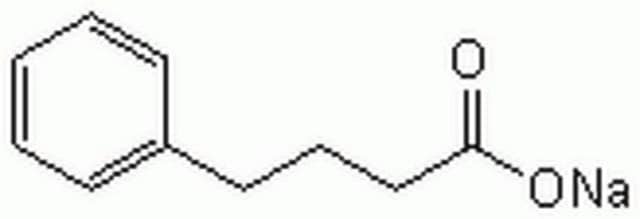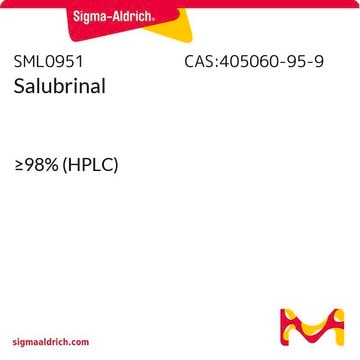580549
Tauroursodeoxycholic Acid, Sodium Salt
Tauroursodeoxycholic is a detergent useful for the solubilization of lipids and membrane-bound proteins.
Synonym(s):
Tauroursodeoxycholic Acid, Sodium Salt, Sodium Tauroursodeoxycholate
Sign Into View Organizational & Contract Pricing
Select a Size
All Photos(1)
Select a Size
Change View
About This Item
Empirical Formula (Hill Notation):
C26H44NO6S · Na
CAS Number:
Molecular Weight:
521.69
MDL number:
UNSPSC Code:
12352106
NACRES:
NA.21
Recommended Products
description
RTECS - KI7372500
Quality Level
assay
≥97% (TLC)
form
solid
manufacturer/tradename
Calbiochem®
storage condition
OK to freeze
color
white
solubility
water: 100 mg/mL
shipped in
ambient
storage temp.
15-25°C
Related Categories
General description
Detergent useful for the solubilization of lipids and membrane-bound proteins. Has cryoprotective effects against hydrophobic bile salts in rats. Also reported to inhibit pepsin activity in vitro.
Application
- Inhibition of endoplasmic reticulum stress combined with activation of angiotensin-converting enzyme 2: novel approach for the prevention of endothelial dysfunction in type 1 diabetic rats.: This study highlights the efficacy of tauroursodeoxycholic acid, sodium salt in reducing endoplasmic reticulum stress, suggesting its utility in preventing vascular complications in diabetes (Gaikwad AB et al., 2022).
Warning
Toxicity: Standard Handling (A)
Other Notes
Ozcan, U., et al. 2006. Science313, 1137.
Miyake, H., et al. 1999. Dig. Dis. Sci.44, 197.
Eto, T. and Tompkins, R.K. 1985. Am. J. Surg.150, 564.
Miyake, H., et al. 1999. Dig. Dis. Sci.44, 197.
Eto, T. and Tompkins, R.K. 1985. Am. J. Surg.150, 564.
Legal Information
CALBIOCHEM is a registered trademark of Merck KGaA, Darmstadt, Germany
Storage Class
11 - Combustible Solids
wgk_germany
WGK 3
flash_point_f
Not applicable
flash_point_c
Not applicable
Certificates of Analysis (COA)
Search for Certificates of Analysis (COA) by entering the products Lot/Batch Number. Lot and Batch Numbers can be found on a product’s label following the words ‘Lot’ or ‘Batch’.
Already Own This Product?
Find documentation for the products that you have recently purchased in the Document Library.
Customers Also Viewed
Maddalena Parafati et al.
Disease models & mechanisms, 11(9) (2018-09-27)
Hepatic steatosis, a reversible state of metabolic dysregulation, can promote the onset of nonalcoholic steatohepatitis (NASH), and its transition is thought to be critical in disease evolution. The association between endoplasmic reticulum (ER) stress response and hepatocyte metabolism disorders prompted
Isabel Castro et al.
Rheumatology (Oxford, England), 59(4), 742-753 (2019-08-05)
Xerostomia in SS patients has been associated with low quality and quantity of salivary mucins, which are fundamental for the hydration and protection of the oral mucosa. The aim of this study was to evaluate if cytokines induce aberrant mucin
Yan Xie et al.
The Journal of biological chemistry, 282(45), 33043-33051 (2007-09-15)
Mammalian small intestinal lipid absorption requires the coordinated interactions of apolipoprotein B (apoB) and the microsomal triglyceride transfer protein (Mttp). The observation that apoB100 displays greater dependence on Mttp availability than does apoB48 prompted us to examine the phenotype of
Lijun Zhou et al.
Diabetes, 59(11), 2809-2816 (2010-08-12)
Obesity impairs adiponectin expression, assembly, and secretion, yet the underlying mechanisms remain elusive. The aims of this study were 1) to determine the molecular mechanisms by which obesity impairs adiponectin multimerization and stability, and 2) to determine the potential role
Huika Xia et al.
Investigative ophthalmology & visual science, 56(11), 6638-6645 (2015-10-16)
To investigate the effects of tauroursodeoxycholic acid (TUDCA) and alpha-lipoic-acid (ALA) on the visual response properties of cat retinal ganglion cells (RGCs) in wholemount retinas. Young adult cats were divided into three groups: control, ALA, and TUDCA. In vitro single-unit
Our team of scientists has experience in all areas of research including Life Science, Material Science, Chemical Synthesis, Chromatography, Analytical and many others.
Contact Technical Service












![PERK Inhibitor I, GSK2606414 GSK2606414 is a cell-permeable, highly potent inhibitor of EIF2AK3/PERK (IC₅₀ = 0.4 nM; [ATP] = 5 µM). Targets PERK in its inactive DFG conformation at the ATP-binding region.](/deepweb/assets/sigmaaldrich/product/structures/180/559/efa716dc-d5fe-4339-a6f0-0103084fc04a/640/efa716dc-d5fe-4339-a6f0-0103084fc04a.png)